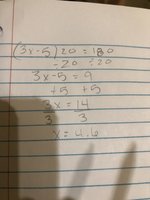You are using an out of date browser. It may not display this or other websites correctly.
You should upgrade or use an alternative browser.
You should upgrade or use an alternative browser.
Use the linear pair postulate
- Thread starter ErickaS
- Start date
- Joined
- Apr 12, 2005
- Messages
- 11,339
Let's just ignore the second one. That makes no sense at all.View attachment 17475 I don’t think my math is right here. Can someone give me direction on this please?
Start from 3x - 5 = 160 and try that again.
X=55Let's just ignore the second one. That makes no sense at all.
Start from 3x - 5 = 160 and try that again.
3X-5=160
+5 +5
3X=165
/3 /3
X=55
Dr.Peterson
Elite Member
- Joined
- Nov 12, 2017
- Messages
- 16,087
The important thing here is that what you do to each side must be done to all of each side, not just to part. So if you want to divide by three, you have to divide (3x - 5) by 3, not just divide 3x by 3 and leave the 5 alone.
Doing that would actually work, if you did it right; but it gets a little ugly, and most people who try it get it wrong. It's easier to deal with the addition or subtraction before you undo the multiplication, because of the way the order of operations works.
Doing that would actually work, if you did it right; but it gets a little ugly, and most people who try it get it wrong. It's easier to deal with the addition or subtraction before you undo the multiplication, because of the way the order of operations works.
pka
Elite Member
- Joined
- Jan 29, 2005
- Messages
- 11,971
The concept of a linear pair postulate was first developed by Edwin Moise who was a R L Moore PhD student. His textbook is based upon Moore's axioms of basic geometry. I served as an assistant in two NSF high school level axiomatic geometry institutes based upon Moore's notes and directed by another one of Moore's students.don’t think my math is right here. Can someone give me direction on this please?
A linear pair postulate: Suppose that points \(A,~B,~\&~C\) are such that \(A-B-C\) and \(D \notin \overleftrightarrow {AB}\) then \(\angle ABD~\&~\angle DBC\) are a linear pair.
BTW: I never knew that degrees were ever use in these notes. We were always concerned with numbers.
Steven G
Elite Member
- Joined
- Dec 30, 2014
- Messages
- 14,382
Here is a numerical example using your mistake.
We know that 15 + 6 = 21. I feel like dividing by 3.
I get 15/3 + 6 = 21/3 or 5+6 = 7 this is not true.
As Dr Peterson said you need to divide every term by 3 giving us
15/3 + 6/3 = 21/3 or 5 + 2 =7 which is correct.
We know that 15 + 6 = 21. I feel like dividing by 3.
I get 15/3 + 6 = 21/3 or 5+6 = 7 this is not true.
As Dr Peterson said you need to divide every term by 3 giving us
15/3 + 6/3 = 21/3 or 5 + 2 =7 which is correct.


